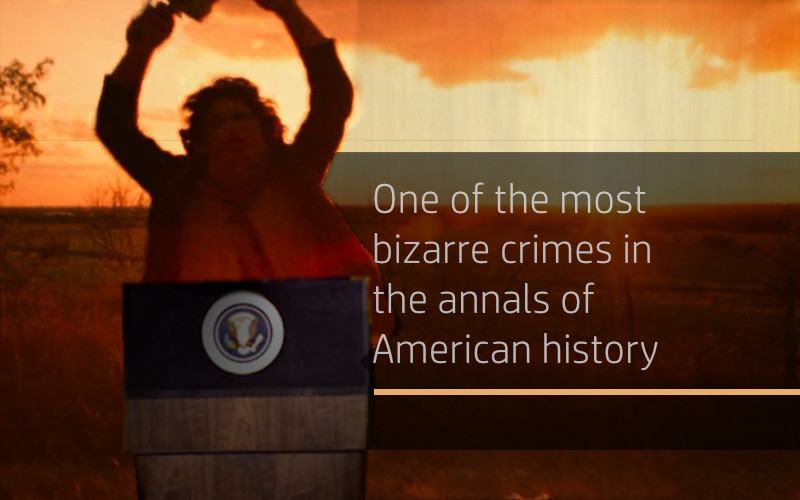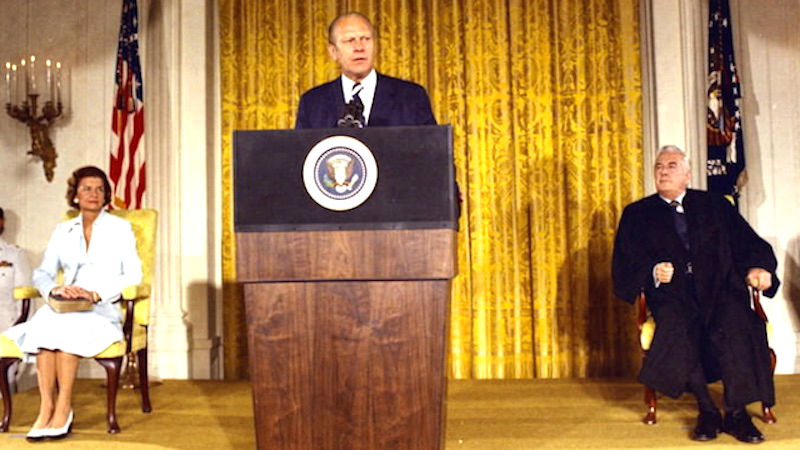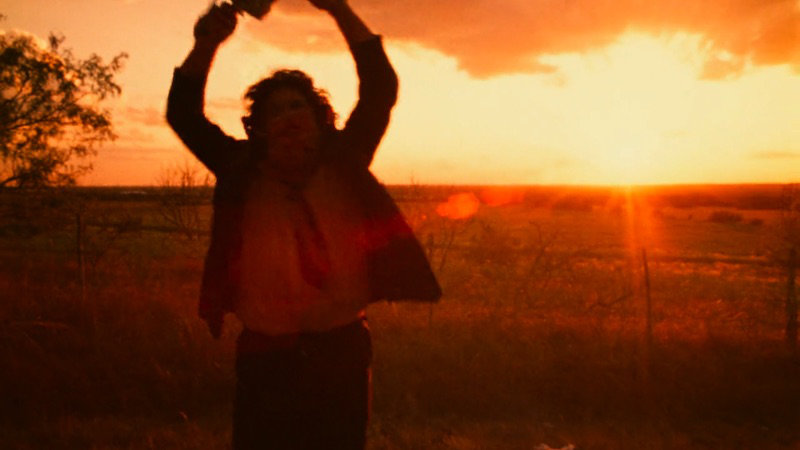
One of the most bizarre crimes in the annals of American history: Richard Nixon, The Texas Chain Saw Massacre, and ‘Our Long National Nightmare’
TODAY AMERICANS WILL pause briefly from a head-spinning election year already marked by several startling twists to reflect on a major milestone in our political history. Exactly fifty years ago on August 9, 1974, Richard Nixon became the first and (still) only US president to resign from office. It is the moment with which my Headpress book Leatherface vs. Tricky Dick: The Texas Chain Saw Massacre as Political Satire begins. On the first page I quote Gerald Ford speaking on that day shortly after taking the oath to succeed Nixon and trying (vainly) to assure the country that with Nixon’s departure “our long national nightmare is over”. The scene and Ford’s line help introduce the idea that Watergate was indeed a ‘nightmare’ with a remarkable number of parallels with a groundbreaking horror film that would premiere just a few weeks later.

I am a child of the 1970s and teen of the 1980s. That means that during my formative years both The Texas Chain Saw Massacre and Richard Nixon occupied similar positions in my adolescent imagination as symbols of ultimate dread. Both the film’s initial theatrical run and Nixon’s presidency were over before I finished my first year of elementary school. Of the two, I first became aware of Nixon as a villainous, exiled figure still haunting the country as an extreme example of criminality and corruption in American politics. Subsequent political commentators (and many politicians, too) routinely evoked Nixon as an absolute rock bottom, never-to-be-matched negative example of leadership failure whose removal from power was like the successful elimination of a poison. The country had, somehow, survived Nixon, his presidency serving as an object lesson going forward of how fragile the nation’s institutions could become if left to the management of bad actors like him.
The Texas Chain Saw Massacre would enter my consciousness some time after that amid a burgeoning boyhood fascination with slashers and early Stephen King novels. There was a lengthy lead-up to the first actual viewing on a rented videocassette, the anticipation of which had been considerably heightened by my having already encountered numerous warnings about the film’s unrelenting, claustrophobic, heart-rending horror. Like Nixon, it was a film to be ‘survived’. It would take some time for me to develop an appreciation of it as a surprisingly rich cultural document containing multiple subtexts, including political ones. My understanding of Nixon would subsequently grow as well, and as an adult my interest in his life and career became an obsession that rivaled my earlier fascination with horror as a teen. There was a lot more to Nixon, too, it turned out. And to Watergate. Decades of studying both the infamous horror film and the infamous historical figure proved similarly rewarding. As recognition of the parallels between the two continued to suggest themselves in persistent ways, a desire to consider those connections resulted in my book-length exploration.

With Leatherface vs. Tricky Dick, I take writer-director Tobe Hooper’s claim that The Texas Chain Saw Massacre “came out of Watergate times” and “was kind of inspired by it, in a lot of ways” and run with it. Sometimes I’m like poor Sally Hardesty, being chased in circles by the mad idea that one of the film’s central purposes is to satirize Nixon and Watergate, the abominable actions of its conspiratorial family of cannibals somehow representing an outlandish allusion to the trauma inflicted upon the American public by Nixon and “all the president’s men”. Other times I’m like Leatherface, aggressively pursuing the thesis and in piecemeal fashion carving out small uncanny connections as I hack away at Chain Saw scene by scene, and sometimes shot by shot. Either way, I follow the path earnestly throughout, albeit with occasional tongue in cheek, inspired by the filmmakers’ own mischievous streak, starting with the film’s opening crawl reporting how ‘an idyllic summer afternoon drive became a nightmare’, and Ford’s proclamation, continuing all the way through to Leatherface whipping his chainsaw high above his head and Nixon’s defiant wave and V-signs before boarding the helicopter on the White House lawn a half century ago.

Truth be told, during the fifty years since Nixon was president and Chain Saw was in theatres, both horror movies and presidential politics have produced what many rightly regard as more extreme horrors that potentially lessen the impact of both The Texas Chain Saw Massacre and the story of corruption and criminality that once forced a US president to resign. But there was a time when both were considered unprecedentedly nightmarish and unsettling, well beyond the pale. If you hear references to Nixon and Watergate today and wonder what it was all about, Leatherface vs. Tricky Dick provides a thorough explanation of how the crisis emerged and played out over the time Chain Saw was conceived, wrote, shot, and edited. My hope is that for fans of the film, the book can be an engaging and even entertaining way of learning the story of Watergate and Nixon’s fall. Meanwhile, no matter your level of familiarity with Chain Saw, you’ll also learn a lot about the film as I maniacally draw attention to and try to unpack different meanings from its many remarkable details. That’s another goal of mine with the book, namely, to give fans of the film something they haven’t thought of before and add to their understanding of its achievement.
In any event, when commentators today (vainly) try to convince their listeners that Watergate and the accompanying “White House horrors” were a nightmare, believe them. To repurpose Chain Saw’s opening crawl, it was indeed ‘one of the most bizarre crimes in the annals of American history’.
-
 Leatherface vs. Tricky DickThe Watergate scandal was a horror show. What better way to satirize it than with a horror movie? A fascinating...£11.99 - £25.00
Leatherface vs. Tricky DickThe Watergate scandal was a horror show. What better way to satirize it than with a horror movie? A fascinating...£11.99 - £25.00
Martin Harris
Like this article?
Related Posts
Comments
Copyright © Headpress

